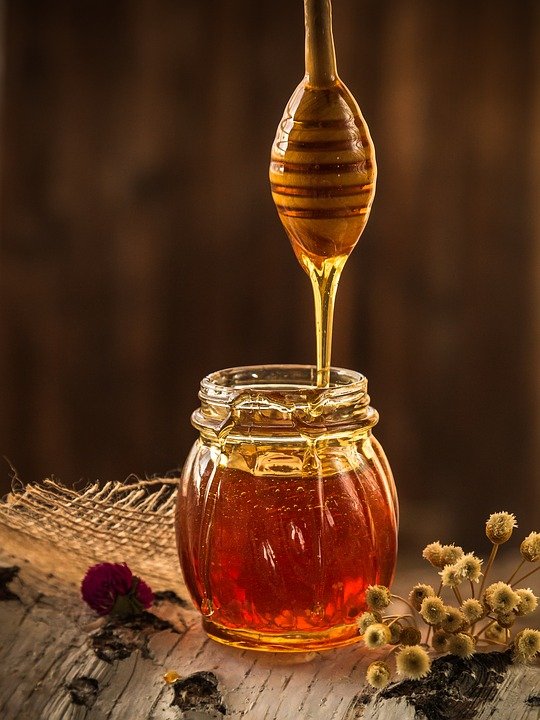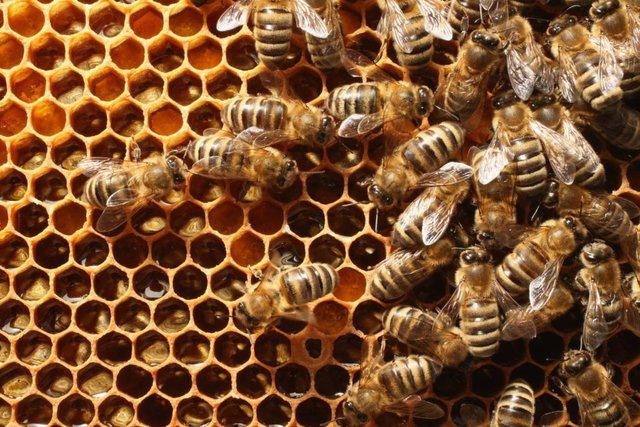INTRODUCTION
Hello steemian, its another beautiful day and i am always excited to make a post on this wonderful platform.
Today, i will like to talk about the antibacteria activities of Honey. we all are familiar with honey, some of us use it for different purposes. But i will like us to see some other uses of it, so as to utilize it properly.
HONEY
Honey is a sweet fluid produced by honey bee, which is generally thick and golden colour in nature. it is composed of sugar and water together with other mineral , vitamin, amino acid, and other compounds. it can be used as sweetener. the darker the honey , the richer its beneficial compound.
It has well-established antimicrobial and antibacterial properties.
its main type of antioxidant is polyphenol, which helps to reduce the risk of diabetes, heart diseases, cancer and dementia.
USES
Honey contains defensin-1-protein which helps to heal wound and burns. Application of honey can facilitate the healing of deep surgical wounds with infection and infected wounds that do not respond to the usual therapy .
honey can cure cold and cough
it protects the gut against an intestinal parasite called Giardia lamblia
It boost fertility in both male and female. it increases the sperm count of a man.
It can cure stomach ulcer
it boosts the brain power and prevents memory loss
Mix 2 teaspoon of honey with vegetable and apply on the hair then wash off after 15 minutes. This is the best natural treatment for dandruff.
Taking honey mixed with hot milk before bedtime induces sleep.
it is a great source of energy
BEE POLLEN
This comes from the pollen ( pollen is essential for sexual reproduction of plants) collected from the body of worker bees as they fly from one flower to another . the worker bees mix it with bee saliva and nectar (nectar is sugar-rich fluid of secretion), and then packed it in to the honeycomb( honeycomb is a natural product made by honeybee where honey and pollen are housed or stored) inside the hive ( hive is a place where bees live).
Bee pollen demonstrates series of actions such as antifungal, antimicrobial, antiviral, anticancer immunostimulating and anti-inflammatory.
ROYAL JELLY
It is a creamy white substance with high nutrient produced by young bee to feed the queen bee. it have antiviral, antifungal and anti-inflammatory properties. it can be taken orally or applied on the skin.
uses
it reduces symptoms of menopause
it increases the movement of fibroblast to a wound which makes it to speed up the healing of wound.
Consuming royal jelly can lead to the reduction of blood sugar, in otherwords it is beneficial for Type 2 diabetes patients.
It is advisable to take royal jelly in small amount and also to seek medical advise because it can interact with some drugs like high blood pressure drug. when one experiences symptoms like excessive itching, dizziness, vomiting , abdominal pain, breathing problem, it is advisable to stop taking it.
HONEYCOMB
this is found in the nest of the honey bee , it is where raw honey and pollen are contained. This hexagonal primsmatic wax is built by the honey bees right inside there nest.
beekeepers remove the honeycomb to harvest honey and returns it after harvest .
You can eat the whole honeycomb, including the honey and the waxy cells . The waxy cell can be chewed as a gum.
They are rich in carbohydrate and antioxidants with traces of several other nutrients.
it contains beewax which helps to lower cholesterol level.
USES
it boost the body's ability to fight some disease causing bacteria and fungi like Staphylococcus aureus, candida albicans, Salmonella enterica and E.coli.
taking 1/2 teaspoon of it is more effective in reducing cough in children than taking cough syrup
it is a good sugar alternative for diabetic patients. But it should be consumed in small quantity
it boost liver function
SCIENCE OF HONEY PRODUCTION BY HONEY BEE
Honey has a unique taste and that is because of complex chemical process, even sugary syrup cannot substitute it.
it is viscous with consistent thickness and has low water content. its main content is carbohydrate that is sugar, and some vitamins, minerals, amino acid, organic acid, enzyme etc.
Honey starts with nectar ( nectar is a sugar-rich liquid with 80% water). Nectar is colourless solution . it is not as sweet as honey and also chemically different from honey. Bees change the nectar chemically. They do this by producing an enzyme called invertase in their salivary gland the enzyme then convert the sucrose(complex sugar) in nectar into glucose and fructose (simple sugar) which is sweeter and easier to digest . This is why honey is easily digested than the normal table sugar ( complex sugar which is sucrose).
Secondly, the fructose in honey taste much sweeter than glucose due to the difference in their atomic arrangement. And honey contains more of this fructose than glucose, that is why it taste sweeter than table sugar.
Honey bee's greatest secret weapon is its ability to convert the complex sugar in nectar into simple sugar . This conversion process is known as Hydrolysis.
For a scientist to carry out this hydrolysis process in laboratory, it is usually very complicated. it requires heating, addition of acids, etc but for bees, its a very simple task. They are more efficient than scientist.
Honey is a supersaturated solution, hence it crystalizes. This crystallization takes place when the long chains of glucose are broken down. This makes it appear lighter in colour
Also browning of honey occurs when heating breaks down the molecular bonds in honey which makes appear darker in colour.
Honey naturally has low moisture which helps in preservation, but when it is exposed to the atmosphere, it will start collecting moisture , when this moisture is above 25%, the honey will begin to ferment . Hence, capped honey is better than uncovered one.
SOME SIDE EFFECT OF HONEY
Too much in take of honey can result to weight gain and risk of hypertension.
excessive intake can increase blood sugar level
it can lead to tooth decay if consumed in excess
it can cause abdominal pain to those who are allergic to it.
THE POTENCY OF HONEY
Honey is so powerful that it is considered first when fighting infection.it can fight bacteria, virus and fungi without creating resistance like most antibiotics. It is so effective against several human pathogens like E.coli, MRSA, vancomycin-resistant enterococci (VRE) etc. Even scientist have attested to the fact that honey is more powerful than most antibiotics. whether it applied on a wound or it is taken orally, honey is very potent. This antimicrobial activity is because of;
the enzymatic production of Hydrogen perioxide , defensin-1-protein in honey and other non-perioxide factors. It makes it possible for honey to fight bacteria infection. Honey has antiviral and antibacteria effect. Natural unheated honey inhibits a broad spectrum of bacterial specie both gram positive and gram negative including those that develop resistance to antibiotics .
Its high sugar content and low water content, together with its acidic properties. since, the minimium PH value for the growth of some bacteria is 4.0 - 4.5, the PH value of honey which is between 3.2 - 4.5 is then an important antibacterial factor.
The concentration of honey: the higher the concentration of honey the greater the antibacterial effect.
Conversely, hydrogen peroxide which is the major contributor to the antimicrobial activity of honey is at different concentration in different honey , this makes honey to vary in the potency of their antimicrobial effect . But Interestingly, it has been observed that no microbial resistance to honey has ever been reported
CHEMICAL COMPOSITION OF HONEY
Some substances in honey have been considered as the main components of honey , which account for its antimicrobial potential.
The following compounds are found in honey;
Polyphenolic Compound: this include flavonoids and phenolic acids, they are the major component of the health promoting properties of honey, they destroy free radical and they generate hydrogen peroxide.
Hydrogen peroxide: This is one of the main antimicrobial components in honey. it is the by-product produced when honey bee harvest nectar.
The antimicrobial effect of this compound in honey increases upon dilution.
They are classified as oxidative biocide , hence they remove electron from chemical structures which result in oxidation. This oxidation action results in the inhibition of microbial growth and irreversible DNA damage through the generation of hydroxyl in honey.Bee defensin-1: it is an antimicrobial peptide found in the blood system and hypopharyngeal gland of the bee. it exhibit activity against yeast, fungi, protozoa , gram positive and gram negative bacteria. it is mostly effective against gram positive bacteria like staph.aureus, Paenibacillus larvea.it plays important role in healing wounds .
Carbohydrates: This is made up of glucose and fructose which are monosaccharides. 82% of honey is sugar and 13% - 23% water. These two things create a very unfavourable environment for microorganisms. This unfavourable environment contributes greatly to the antimicrobial activity of honey.
CONCLUSION
Honey being an effective antimicrobial agent should become part of our diets. This will keep our system free from human pathogens.
Thanks for stopping by
God bless you


@peggybaby, Thanks for sharing with us on @campusconnect what an interesting article . Continue sharing your quality contents with us here we love and appreciate your effort ,Thanks
Downvoting a post can decrease pending rewards and make it less visible. Common reasons:
Submit
Thanks
Downvoting a post can decrease pending rewards and make it less visible. Common reasons:
Submit
Hello @peggybaby , your post have been supported by @reminiscence01 using @steemcurator07 account.
Thank you for making a post in the #Science/ #Computing/ #Technology category. We appreciate the work you have put in this post.
We have analyzed your post and come up with the following conclusion:
Downvoting a post can decrease pending rewards and make it less visible. Common reasons:
Submit